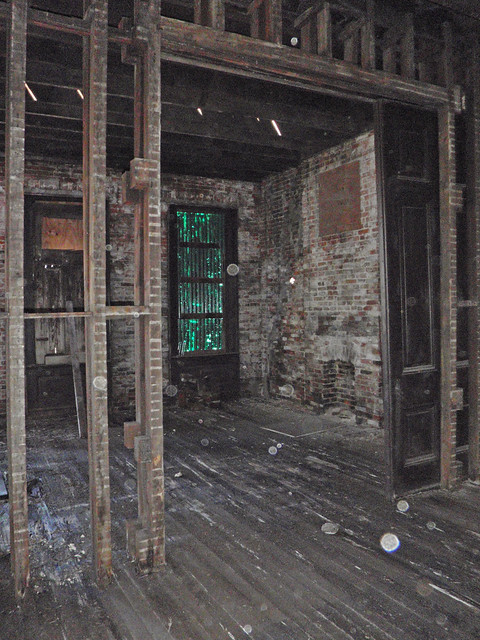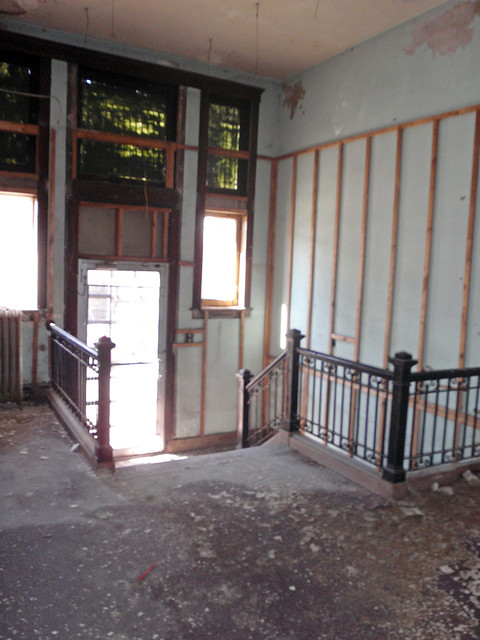Friday, December 27, 2013
Warehouse Lost to Fire Was One of Chouteau's Landings Oldest
The three story and adjacent one story warehouses lost to a four-alarm fire on December 16th may have been one of the oldest surviving buildings on Chouteau's Landing. City property records list the structure as being built in 1902, however the intricate brick work of it's 1st street elevation suggested that it may have been older. Photo above by Ann Aurbach
Consulting the 1876 Whipple fire insurance maps, that are available online from Washington University and the Missouri History Museum, I found both the three story building, listed as "Central Warehouse A", and the adjacent one story warehouse to the south, listed as "Central Warehouse B". Just north, the surviving three story warehouse hat has the large corrugated sheet metal structure perched on its roof also appears to be on the 1876 map. The buildings are in the upper right portion of the map above.
Other than a few small buildings surviving on 4th Street, the only other structure extant from the 1876 map is the St. Mary of Victories Church and adjacent school. The church is by far the oldest structure in the area, having been constructed in 1843.
The warehouses along 1st Street, or Main Street as it was called at that time, must have been constructed right around 1875-1876 because they do not show up in Compton & Dry's aerial view of the area from Pictoral St. Louis, which was published in 1875.
By the time this 1909 Sanborn map was published the giant Crumden Martin complex by architects Mauran, Russell & Garden was taking shape a block south between Cedar and Gratiot. The buildings shown above had been built between 1904 and 1907. The building that partially burned just over 2 years ago, and still stands roofless would be built three years later in 1912. The Powell Square Building, which was built for Milliken Pharmaceutical in 1916 a block west at 217 Cedar, was wastefully demolished by the City of St. Louis early this year. The Crumden Martin block would be finished out at Cedar & 2nd in 1920 with the construction of a crenelated concrete structure designed by Tom P. Barnett.
Central Warehouse A and a smaller portion of Central Warehouse B would later survive partial demolition for a railroad trestle that connected existing alignments allowing trains to turn south from the central rail yards south of Downtown to the trestle running along the riverfront. I am unsure of the date of construction of the trestle, but it shows up in an aerial view from 1958.
This view from 1st Street at Cedar shows the small portion of Central Warehouse B that remained after the trestle construction.
As was common in the first half of the 20th Century, the testle construction took only what was needed from the larger Warehouse A building, and constructing a new board formed concrete wall to close up the building just a few feet from the trestle. Ann Aurbach has posted about a dozen photos of the grizzly aftermath of the recent fire that finally destroyed both Warehouse A and B on her blog Biscuits with Honey.
What ultimately happens to this site and to the larger Chouteau's Landing district remains to be seen. The district's remaining historic buildings and growing stock of vacant land hold great potential with a location immediately adjacent to Downtown St. Louis, the Arch grounds and the riverfront, which will soon be vastly improved with a new bike and walking trail currently under construction by Great Rivers Greenway including a trailhead at the foot of Chouteau Avenue. Despite these assets the district remains gravely isolated by the urban planning mistakes of the last century and portions of MVVA's plans to revamp the Arch Grounds and connect to Chouteau's Landing have apparently been eliminated due to budgetary constraints. Needless to say, it will take some major infrastructure changes/improvements and developers willing to risk investing in uncharted territory to tap the potential of Chouteau's Landing.
Friday, December 20, 2013
Unique Brick Facade Lost on Olive Boulevard
Last weekend I was driving out Olive Boulevard past Hanley Road and noticed that this unique building has disappeared. The interesting feature that made this building stand out was the sculpture like wall of projecting and recessed rectangular brick panels. The buildings entrance canopy was also attractive but ingeniously simple, composed of some steel tubes and a standard pair of standard double T precast concrete sections.
Another view shows that what would ordinarily have bee a plain and boring windowless facade was transformed into an attractive work of art with some simple pushing and pulling of the brick face. The effect was subtle, yet more powerful due to the random pattern used.
The building was somewhat oddly configured with two relatively narrow wings. The rear wing had multiple garage doors opening to the asphalt lot. Whatever business occurred back there was masterfully screened from view to the street. I do not know who the architect was, so if any reader happens to know, please share. The building was for sale last year, but apparently the new owner did not purchase for the building and there was no sign on the lot indicating what is to come as of last week. If they had been looking for a vacant site, they would have needed to go no further than two lots west to the still vacant site where the Arcade Lanes bowling alley burned in 2003.
Thursday, December 12, 2013
Chipping Away at Chouteau's Landing

UPDATE: Yesterday A City official contacted me about this demolition. The City did not demolish the building due to the earlier condemnation as I assumed, but instead, the application came from the owner. The demolition was approved without review because apparently in the transfer of information from City Hall, where the application originated to 1520 Market Street where the Cultural Resources Office is located, the address of the building was incorrectly entered. The address entered put the building outside of the S. 4th Street National Register district where the building is actually located, so CRO did not review the application. Also, it is rumored that a new owner has closed on the purchase of the property from Steve Murphy.
On Wednesday this photo of the demolition of 818-822 S. 4th Street was posted on Twitter by Alternative Apparel, which is part of the Collective at the MX. The building was located at 4th & Lombard, just north of the old approach ramp for the MacArthur Bridge, on the western edge of the now moribund Chouteau's Landing District.

Built in 1890 for a saloon and butcher shop, the building has been been empty for many years. It was most recently known for the colorful paintings by local artist Peat Wollaeger. No news if Beardy McGreen will be saved. The structure was a contributing building in the South Fourth Street Commercial District, a National Register historic district that was created in 2006.

A view of the building from Lombard. Earlier this year the City of St. Louis issued an emergency structural condemnation for reasons unknown.

The structure at the rear of the property is a separate building that was built in 1917 as an office and warehouse for Saxony Mills, a large flour mill located across Lombard since 1849. The mill was demolished for the construction of Interstate 55. The 1909 Sanborn map for the area shows this building as a 3 story structure. It is unknown when the upper floors were removed. Also unknown is whether this structure is being demolished with the front building. They were built on separate parcels and later combined into one property. I fear for this building because with "emergency" demolitions the City is typically not smart enough to discern that there is more than one building on a parcel, so everything gets wrecked.

The interior of 818-822 S. 4th had been gutted down to studs. As of a few years ago, the interior of the structure was in decent shape although there were soft areas in the floors and a few isolated areas where the joists were quite deteriorated. The masonry shell was in good condition and the overall structure sound.

Another interior view of the second floor of 818-822 S. 4th.

Interior view of the entrance to the building at 321 Lombard.

This building had apparently been used more recently than the building on 4th Street and was in excellent condition.

An interior view of the loading dock area of 321 Lombard at the north end of the building. The building is a concrete frame structure with brick infill walls.

The buildings at 818-822 S. 4th, 317 Lombard and a small one story addition at 812-816 S. 4th are at the center of the historic district. Their loss (if indeed the entirety is being demolished) would be very damaging to the continuity of the district, which with the large gap in the middle was already fragile. As of the beginning of last week, the Cultural Resources Office had not received anything an application for this demolition,
If this building had begun to collapse into one of the streets, which no one has made indications of, an "emergency" action might be justified, but if this was simply another building that lost part of its roof or a section of floor to inward collapse, then we are losing another building (or maybe two) for no good reason at all.
Subscribe to:
Comments (Atom)
